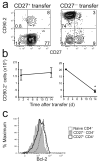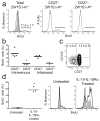Different routes of bacterial infection induce long-lived TH1 memory cells and short-lived TH17 cells
- PMID: 19935657
- PMCID: PMC2795784
- DOI: 10.1038/ni.1826
Different routes of bacterial infection induce long-lived TH1 memory cells and short-lived TH17 cells
Abstract
We used a sensitive method based on tetramers of peptide and major histocompatibility complex II (pMHCII) to determine whether CD4(+) memory T cells resemble the T helper type 1 (T(H)1) and interleukin 17 (IL-17)-producing T helper (T(H)17) subsets described in vitro. Intravenous or intranasal infection with Listeria monocytogenes induced pMHCII-specific CD4(+) naive T cells to proliferate and produce effector cells, about 10% of which resembled T(H)1 or T(H)17 cells, respectively. T(H)1 cells were also present among the memory cells that survived 3 months after infection, whereas T(H)17 cells disappeared. The short lifespan of T(H)17 cells was associated with small amounts of the antiapoptotic protein Bcl-2, the IL-15 receptor and the receptor CD27, and little homeostatic proliferation. These results suggest that T(H)1 cells induced by intravenous infection are more efficient at entering the memory pool than are T(H)17 cells induced by intranasal infection.
Figures







Comment in
-
Glimpsing the real CD4+ T cell response.Nat Immunol. 2010 Jan;11(1):47-9. doi: 10.1038/ni0110-47. Nat Immunol. 2010. PMID: 20016511 No abstract available.
References
-
- Jenkins MK, et al. In vivo activation of antigen-specific CD4 T cells. Annu Rev Immunol. 2001;19:23–45. - PubMed
-
- Ahmed R, Gray D. Immunological memory and protective immunity: understanding their relation. Science. 1996;272:54–60. - PubMed
-
- Sallusto F, Lenig D, Forster R, Lipp M, Lanzavecchia A. Two subsets of memory T lymphocytes with distinct homing potentials and effector functions. Nature. 1999;401:708–712. - PubMed
-
- Masopust D, Vezys V, Marzo AL, Lefrancois L. Preferential localization of effector memory cells in nonlymphoid tissue. Science. 2001;291:2413–2417. - PubMed
-
- Reinhardt RL, Khoruts A, Merica R, Zell T, Jenkins MK. Visualizing the generation of memory CD4 T cells in the whole body. Nature. 2001;410:101–105. - PubMed
Publication types
MeSH terms
Substances
Grants and funding
LinkOut - more resources
Full Text Sources
Other Literature Sources
Medical
Research Materials

